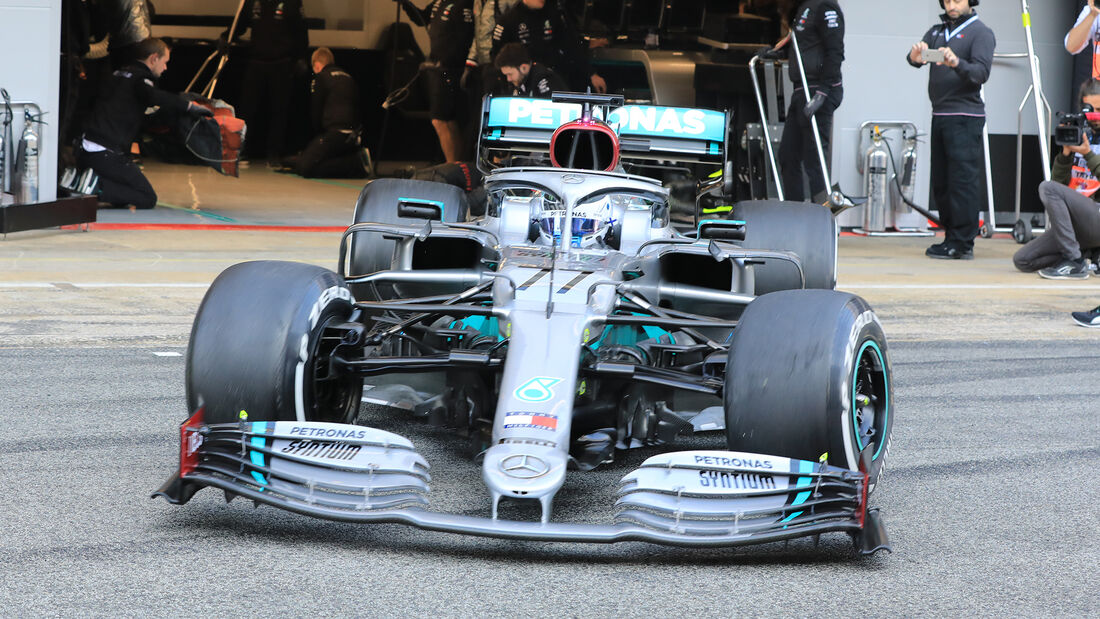- Login or Register
No account yet? Sign up

I honestly think the extended knuckle is purely aerodynamic, moving the suspension arms out of the way of the barge boards and diffuser. Doing so makes you have awkward angles to get the geometry you're looking for, it is certainly an interesting engineering challenge for a variety of reasons.PlatinumZealot wrote: ↑18 Feb 2020, 02:42OK. Never denied it.
I said i had an idea how it would work. Just wanted to see someone say it.
Here goes:
When the steering is straight, the pushrod top joint and the bottom joint has to make a straight line to king pin axis.
This way when you turn right or left it pulls on the push rod. (thinking of a cricular arc, a point going away from the top of the arc pulls on the pushrod shortening the ride height, the top of this arc intersects with another line drawn from the king pin axis to the knuckle to the top joint of the pushrod so that the point is neutral (or in zero position. When your turn left the point moves way. When your turn right the point moves away.
Thats it.
I dunno.. I mean with regular street cars.. We can get a lowering or raising of a corner of the car when you steer. Because of a number of reasons (king pin offset, caster angle camber angle)..maybe you call this the traditional way?
it interesting other teams could be achieving it whout this extended knuckle thing. I really don't know.
I really want to know if this is indeed the primary purpose of doing the suspension like this. Do photos show Mercedes dropping their nose into turns? Maybe with their low rake angle they can afford to be dropping the nose of the car?



The picture you used looks like normal positive Ackermann to me.PlatinumZealot wrote: ↑24 Feb 2020, 16:49We know the steering is "anti-ackerman" in F1 where the outside tyres turn more at an angle.

Is this tie rod position known as zero point or center point steering?Tim.Wright wrote: ↑24 Feb 2020, 21:58The picture you used looks like normal positive Ackermann to me.PlatinumZealot wrote: ↑24 Feb 2020, 16:49We know the steering is "anti-ackerman" in F1 where the outside tyres turn more at an angle.
With the steering axis so far inboard I don't see how you can have anti-Ackermann without having the toe link attachment inboard of the brake ducts.
https://external-preview.redd.it/gcKxoH ... 576849072f
Depends where exactly that lower wishbone actually pivots but it looks like it could be neutral on the ackerman just from that single photo.Tim.Wright wrote: ↑24 Feb 2020, 21:58The picture you used looks like normal positive Ackermann to me.
With the steering axis so far inboard I don't see how you can have anti-Ackermann without having the toe link attachment inboard of the brake ducts.

Tim.Wright wrote: ↑24 Feb 2020, 21:58The picture you used looks like normal positive Ackermann to me.PlatinumZealot wrote: ↑24 Feb 2020, 16:49We know the steering is "anti-ackerman" in F1 where the outside tyres turn more at an angle.
With the steering axis so far inboard I don't see how you can have anti-Ackermann without having the toe link attachment inboard of the brake ducts.

Yes it would, the wing span is levering against the nose mounts, the load is transmitted to the bulkhead where it's distributed to the front axle. The thing is both sides of the wings generate lift, one side generates more lift if it's closer to the ground than the other. Both sides press the whole axle to the ground because of the way the wing is mounted to the chassis. But the loads are tricky to measure because there's inherent compliance to the suspension and the chassis itself.Zynerji wrote: ↑25 Feb 2020, 03:07Does loading the outboard side of the wing of the inside tyre help load the inside tyre, or does it transfer to both front wheels equally?
I'd assume it would transfer load to the inside pylon, and "tilt" the nose in that direction, but im not sure. Part of my brain says it would, and possibly lift the outside pylon like a lever, but with zero real world experience, I'm simply not sure, and would like some professional input.
Tyvmgodlameroso wrote: ↑25 Feb 2020, 05:07Yes it would, the wing span is levering against the nose mounts, the load is transmitted to the bulkhead where it's distributed to the front axle. The thing is both sides of the wings generate lift, one side generates more lift if it's closer to the ground than the other. Both sides press the whole axle to the ground because of the way the wing is mounted to the chassis. But the loads are tricky to measure because there's inherent compliance to the suspension and the chassis itself.Zynerji wrote: ↑25 Feb 2020, 03:07Does loading the outboard side of the wing of the inside tyre help load the inside tyre, or does it transfer to both front wheels equally?
I'd assume it would transfer load to the inside pylon, and "tilt" the nose in that direction, but im not sure. Part of my brain says it would, and possibly lift the outside pylon like a lever, but with zero real world experience, I'm simply not sure, and would like some professional input.

K&C??Greg Locock wrote: ↑26 Feb 2020, 12:024 pages in on F1 'Technical' and nobody has done K&C
Neither have I, it's a busman's holiday